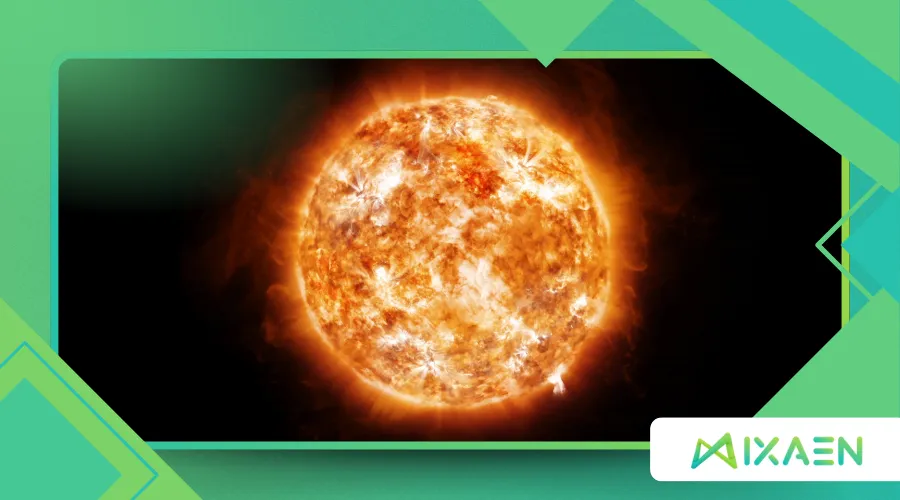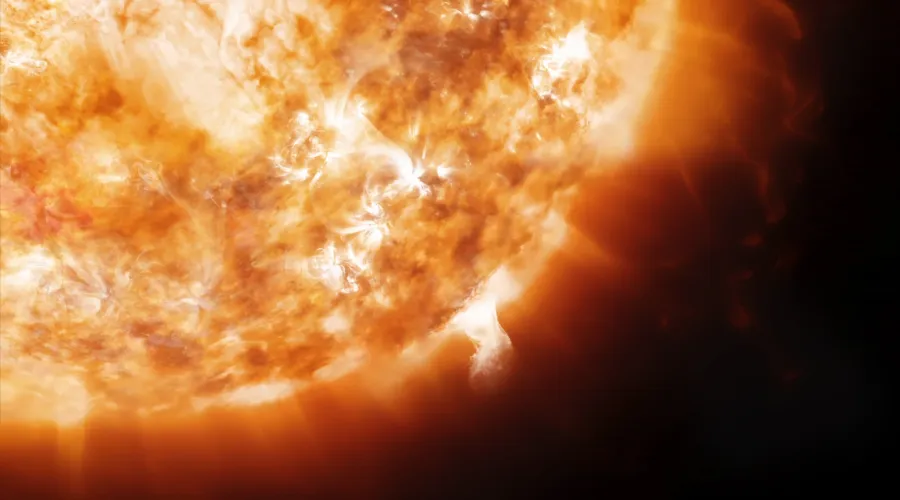Solar Prominences: Loops of Plasma and Magnetic Energy

Solar prominences are mesmerizing displays of plasma and magnetic energy dancing across the Sun’s surface, captivating astronomers and casual stargazers alike.
Anúncios
These colossal structures, often stretching tens of thousands of miles, embody the Sun’s dynamic nature, revealing its restless power through intricate loops and arcs.
Far from mere cosmic spectacles, they hold clues to the Sun’s inner workings, its influence on space weather, and humanity’s technological vulnerabilities.
This article dives into the science, beauty, and significance of solar prominences, weaving together cutting-edge research, vivid examples, and thought-provoking insights to illuminate their role in our universe.
What Are Solar Prominences?
Picture a fiery loop, glowing red against the Sun’s blinding surface, twisting like a cosmic ribbon caught in an invisible breeze.
Solar prominences are massive structures of plasma—ionized gas—held aloft by the Sun’s magnetic fields.
Unlike solar flares, which erupt explosively, prominences are relatively stable, sometimes lingering for days or weeks.
They form in the chromosphere, the Sun’s middle atmospheric layer, where magnetic field lines trap and shape dense plasma into loops, filaments, or towering pillars.
These structures vary wildly in size and behavior.
Some prominences extend over 600,000 miles, dwarfing Earth, while others collapse or erupt, releasing energy that can ripple through the solar system.
A 2023 study from the National Solar Observatory revealed that prominences can store up to (10^{15}) joules of magnetic energy, enough to power global electricity needs for years.
This immense energy underscores their role in solar dynamics and space weather.
Understanding solar prominences is crucial for predicting solar activity, which can have significant impacts on satellite operations and communications on Earth.
The Physics Behind the Spectacle
At their core, solar prominences are a battleground of forces: gravity pulling plasma downward, magnetic fields pushing it upward.
The Sun’s magnetic field, generated by its churning interior, forms complex loops that act like invisible scaffolding.
Plasma, hotter than a million degrees Celsius, flows along these magnetic highways, creating the glowing arcs we observe.
Imagine a lava lamp on a cosmic scale.
Just as heated wax rises and falls in mesmerizing patterns, plasma in prominences follows magnetic field lines, cooling and condensing as it loops.
When the magnetic fields destabilize—due to shifts in the Sun’s dynamo or interactions with nearby fields—the prominence can collapse or erupt, sometimes triggering coronal mass ejections (CMEs).
These eruptions hurl charged particles into space, potentially impacting Earth’s magnetosphere.
The physics is intricate.
Prominences form in regions of strong magnetic shear, where field lines twist and tangle.
This shear stores energy, like a coiled spring, until it releases in spectacular fashion.
Observations from NASA’s Solar Dynamics Observatory (SDO) show that prominences often align with filament channels—dark, thread-like structures visible against the Sun’s disk.
When viewed from the side, these filaments become the glowing prominences we marvel at.
Understanding these dynamics not only enhances our knowledge of solar phenomena but also aids in developing better predictive models for solar activity.
+ The End of the Sun: When and How Our Star Will Die, According to Science
A Dance of Creation and Destruction
The life cycle of solar prominences is a cosmic drama of creation, equilibrium, and destruction.
They often form near sunspots, where magnetic activity is intense.
As plasma cools in the chromosphere, it condenses into dense loops, suspended like beads on a string.
Some prominences remain stable, their plasma flowing in hypnotic patterns, while others meet a fiery end.
Take the 2012 “Great Prominence” event, observed by the SDO.
A massive loop, spanning 200,000 miles, hovered for days before erupting into a CME.
The event sent a billion tons of plasma hurtling toward Earth, narrowly missing our planet but sparking auroras in polar regions.
This example highlights the dual nature of prominences: serene yet volatile, beautiful yet potentially destructive.
Another striking case occurred in 2024, when a prominence near the Sun’s north pole formed a rare “polar crown” structure.
Unlike typical prominences, this one extended across the pole, defying usual magnetic patterns.
Scientists at the European Space Agency noted its unusual stability, lasting over a month before dissipating.
Such events challenge existing models and push researchers to refine their understanding of solar magnetism.
The continuous study of these phenomena provides valuable insights into the Sun’s behavior and its impact on the solar system.

Why Solar Prominences Matter to Earth
Solar prominences don’t just dazzle—they shape our technological world.
When they erupt, they can trigger CMEs, sending charged particles that interact with Earth’s magnetic field.
These interactions can disrupt GPS signals, satellite operations, and even power grids.
The 1989 Quebec blackout, caused by a CME linked to a prominence eruption, left millions without power for hours, costing an estimated $2 billion in damages.
The stakes are higher today.
Our reliance on technology—smartphones, internet, global navigation—makes us vulnerable to space weather.
Prominences are key players in this arena, acting as both predictors and catalysts of solar storms.
By studying them, scientists can improve forecasting models, giving us a fighting chance to protect infrastructure.
Here’s a quick breakdown of their impact:
| Event Type | Potential Impact | Mitigation Strategy |
|---|---|---|
| CME from Prominence | Satellite malfunctions, power grid failures | Early warning systems, satellite shielding |
| Radio Blackouts | Disrupted communications, GPS errors | Backup systems, real-time monitoring |
This table illustrates why solar prominences demand attention.
Their eruptions aren’t just cosmic fireworks—they’re events with real-world consequences.
With advancements in monitoring technology, the ability to predict and mitigate the effects of solar events is improving, providing a safeguard for our interconnected world.
For more detailed information, you can visit the National Aeronautics and Space Administration (NASA) website.
Observing the Unseen: Tools and Techniques
Catching solar prominences in action requires cutting-edge technology.
Ground-based telescopes, like the Daniel K. Inouye Solar Telescope, capture high-resolution images of the Sun’s chromosphere, revealing fine details of prominence structure.
Space-based observatories, such as the SDO and ESA’s Solar Orbiter, provide multi-wavelength views, showing plasma at different temperatures and magnetic configurations.
Amateur astronomers can also join the chase.
H-alpha telescopes, which filter specific wavelengths of light, make prominences visible as glowing red arcs.
These tools democratize solar observation, letting enthusiasts witness the Sun’s grandeur firsthand.
Have you ever wondered what it’s like to see a prominence erupt in real time, its plasma twisting against the void of space?
Data from these instruments feed predictive models.
For instance, machine learning algorithms now analyze prominence behavior to forecast eruptions, improving space weather predictions by up to 30% compared to older methods.
This blend of technology and curiosity drives our understanding forward.
As more sophisticated tools become available, the study of solar prominences will continue to evolve, providing deeper insights into solar dynamics.

The Broader Cosmic Context
Solar prominences aren’t just solar phenomena—they’re part of a universal story.
Stars across the galaxy exhibit similar magnetic structures, from young, volatile stars to aging giants.
By studying our Sun’s prominences, we gain insights into stellar evolution and magnetic activity elsewhere in the cosmos.
Consider Betelgeuse, a red supergiant.
Recent observations suggest it hosts prominence-like structures, albeit on a grander scale.
These findings hint that magnetic processes governing solar prominences may be universal, shaping how stars interact with their environments.
This connection ties our Sun to the broader tapestry of the universe, reminding us that even local phenomena have cosmic significance.
Here’s a comparison to put things in perspective:
| Feature | Sun’s Prominences | Betelgeuse’s Prominences |
|---|---|---|
| Size | Up to 600,000 miles | Potentially millions of miles |
| Temperature | ~10,000–1,000,000°C | Cooler, ~3,500°C |
| Stability | Days to weeks | Unknown, likely longer |
This table underscores the diversity of magnetic phenomena across stars, with solar prominences as our closest laboratory.
Understanding these cosmic connections enriches our knowledge of not just our star but the entire universe.
++ Coronal Hole Explained: Everything About This Opening in the Sun’s Magnetic Field
Challenges and Frontiers in Research
Despite advances, solar prominences remain enigmatic.
Their stability defies simple models—why do some persist while others erupt?
Magnetic reconnection, where field lines snap and reform, plays a role, but the triggers are elusive.
Current research focuses on 3D modeling, using supercomputers to simulate prominence dynamics.
These models reveal how small changes in magnetic fields can tip the balance from stability to chaos.
Another frontier is their role in solar cycles.
Prominences peak during the Sun’s 11-year cycle, particularly near solar maximum, expected next in mid-2025.
Tracking their frequency and behavior could unlock secrets about the Sun’s magnetic engine, aiding long-term space weather forecasts.
As we continue to explore these challenges, our understanding of solar prominences will deepen, paving the way for future discoveries.
A Call to Marvel and Understand
Solar prominences are more than scientific curiosities—they’re a reminder of our star’s restless energy and its profound impact on our world.
They challenge us to look upward, to question, and to innovate.
As we refine our tools and models, we edge closer to predicting their behavior, safeguarding our technology, and deepening our cosmic perspective.
Next time you hear about a solar storm, think of those glowing loops of plasma, suspended in a delicate dance of magnetic forces.
They’re a testament to the Sun’s complexity and a call to keep exploring.
For now, solar prominences remain one of nature’s grandest spectacles, inviting us to marvel at the universe’s untamed beauty.
